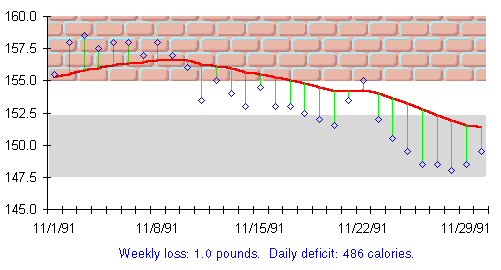
If you make minor monthly adjustments to your food intake based on the slope of the trend your weight will rarely stray outside the 5 pound band requiring mandatory adjustments to your calorie intake. But, over the years, stresses and circumstances unanticipated by carefully drawn plans will occur: a four month tour de France gastronomique, a coupla years in the slammer for insider trading, a sudden obsession with cheesecake, a bout of malaria. Events like these may set you heading for a serious weight problem. But long before things spiral out of control, the trend line will detect the danger and invoke stronger measures to avert catastrophe.

The five pound band around the goal weight, shown here in grey, contains most normal fluctuations. A ten pound region limits the permissible variation. The brick wall indicates the region the trend is prohibited from entering. With a goal weight of 150 pounds, brick walls are built at 145 and 155. (Only the upper brick wall is shown on this graph, as it's the one most of us worry about.) If the trend at the end of a month exceeds 155 pounds, the warning bell sounds and immediate action is taken to return the trend to the goal. What immediate action? Simply resuming the very same meal plan you used to lose weight in the first place. You know it works; you adjusted it over the duration of your diet into something you can live with. Dust it off and use it now.
With a 10 pound brick walls around your goal weight, even if you hit the wall above your goal, you only need to take off 5 pounds. With a 500 calorie a day deficit you can do that in little more than a month so you're hardly looking at a severe calorie cutback nor a long-term diet to restore stability. In the unlikely event of the trend ending a month more than five pounds below the goal, add about 500 calories a day to your diet to bring it back.
In the chart above, the trend ended the previous month above 155, indicating the brick wall had been hit. The meal plan, calculated for a 500 calorie a day deficit, was put into effect immediately. The trend continued to rise for the first week of the month since daily weight remained above the trend line, but before long the diet took hold and the trend began to fall at the expected rate of about a pound a week. By month's end, the trend had fallen to within the 5 pound band around the goal. After hitting a brick wall, it's best to continue the meal plan until the trend goes past the goal weight since going off the diet may cause the trend to bounce upward, but you could end the diet at the conclusion of this month and return to managing the trend within the 5 pound band around 150.
If you adjust your calorie intake month by month, variations outside the 5 pound band will be infrequent. Since you make adjustments when the 5 pound band is violated, hitting the brick wall will be exceedingly rare. Still, it can happen, and if and when it does you are ready. If the first and second layers of defence against gaining weight fail, a sure-fire solution, resuming the diet that got you to the goal in the first place, is invoked and will correct the problem, whatever its cause, in little more than a month. If you do hit the wall, try to understand why. Hitting the wall indicates the normal weight regulating feedback failed, and once you figure out why you can avoid the discomfort of dieting in the future.
But even if you hit the wall and have to diet, it's not for long, and the incipient weight gain is corrected well before your clothes don't fit or anybody notices you've gained a pound. Hitting the wall and dieting back to the goal is a private matter between you and the trend line, and you are the sole beneficiary. The best way to think of the brick wall is like a parachute. You hope you'll never need it, but it's nice to know it's there.
By John Walker